Chapter 80 – Tiananmen
BETWEEN FIVE WORLDS: CHINA, RUSSIA, JAPAN, PERU AND AUSTRALIA.
BETWEEN FOUR CAREERS and FIVE LANGUAGES
A Story of Regime Brutality and Media Mendacity
1. Images
2. Background History
3. Tiananmen Square Massacre?
4. State Department Records
5. Tankman photo
From the beginning it should have been clear simply from the conflicting images of Tiananmen Square events, June 3 and 4, 1989, that we needed to look more deeply.
The background had begun more than a month earlier, with the ending of the evil Cultural Revolution. There had been the death of Hu Yao-bing and outflow of sympathy for his reformist ambitions. There had also been the death of Zhou-Enlai who had done so much to open China to the outside world.
Was that the end of the reformism?
As a conservative leadership settled into Beijing that seemed to be the case.
1. Images
But then seemingly out of nowhere emerged the massive student demonstration in Tiananmen Square followed by images of soldiers marching towards Tiananmen Square and firing indiscriminately into helpless crowds of protesting civilians and students.
Unprovoked murder?
But knowing China I realised there had to be more to the story, and it was not hard to find.For shortly after the alleged Tiananmen Square massacre one needed only to scan the Internet to find images of charred soldier corpses hanging from overpasses with traffic moving serenely underneath, scorched and mutilated PLA soldiers strung up on the sides of badly damaged busses, badly burned PLA solders hiding in doorways.
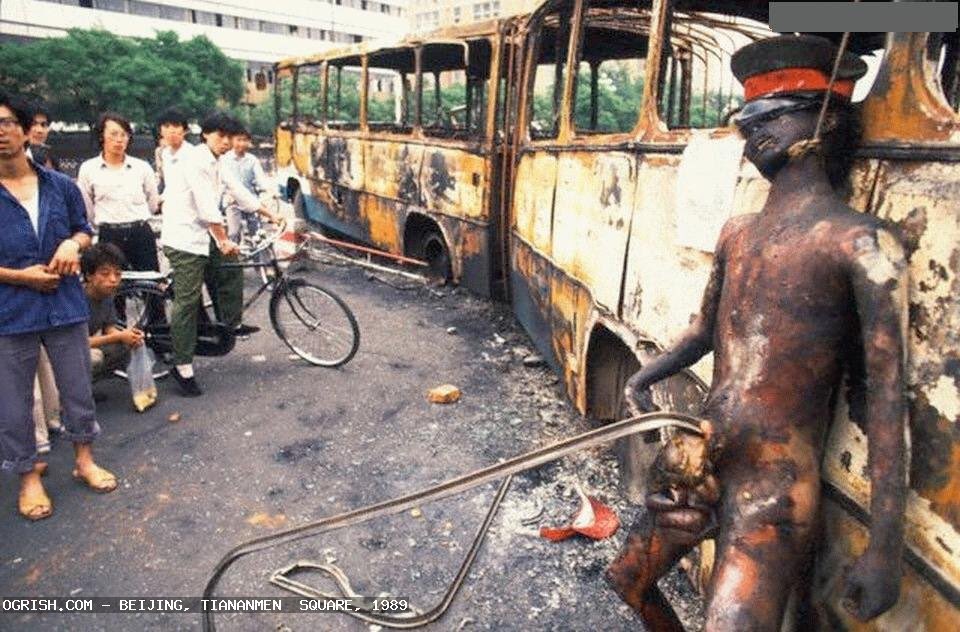
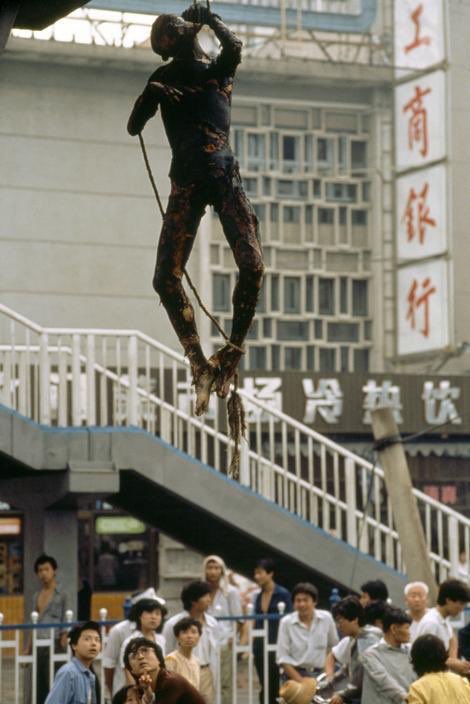
What came first? Soldiers shooting wildly into crowds, or the PLA mutilated corpses?
Even the slightest twinge of curiosity should have forced people to realise that the so-called Tiananmen ‘massacre’ involved more than soldiers marching up a street and shooting at students.
Some how, some where someone had been able to unleash extraordinary violence against PLA soldiers before the time we were being told the soldiers were shooting the civilian and student protestors.
Equally impressive was the uncaring attitudes of the crowds witnessing the atrocities against the soldiers.
And why the almost complete failure of mainstream Western media to investigate these photos which could be downloaded on TV at any hour and for months after the event.
They destroyed entirely the narrative of unprovoked aggression.
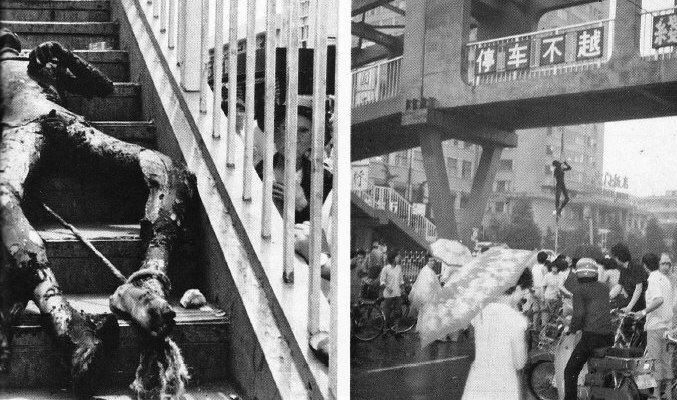
2. Background History
To say the Communist Party began its rule in China with popular support is to say the obvious. Even the refugees I met in Hong Kong in the early sixties admitted that while they could not have lived under a communist regime they had fled, China at the time had no choice but to accept it.
The alternative – the corruption and chaos of the rival Nationalist regime – was unbearable.
…
And for a while the regime performed well. But then news of the stupidity and egoism of Mao Tsetung’s Great Leap Forward in the late fifties began to trickle out to us in Hong Kong – chaos in the countryside, mass starvation, even cannibalism.
What was going on?
Things recovered somewhat in the early sixties as moderates like Zhou Enlai and Deng Xiaoping took over. But it was not long before the fanatics were back – this time with a monster called the The Great Proletarian Cultural Revolution. The year – 1966.
Those of us who saw the remnants of this disaster when China opened to outsiders in the early seventies should have been appalled. Certainly I was – Potemkin factories producing slogans rather then goods, constant stories of people who were ’struggled against’ (beidoufa) for minor infractions of Maoist dogma or rumours of past bourgeois connections, and so on.
Patrick Chovanec
@prchovanec
June 4, 1989, 4:45am – Infantryman Cui Guozheng is stabbed, lynched, and burned at Chongwenmen intersection
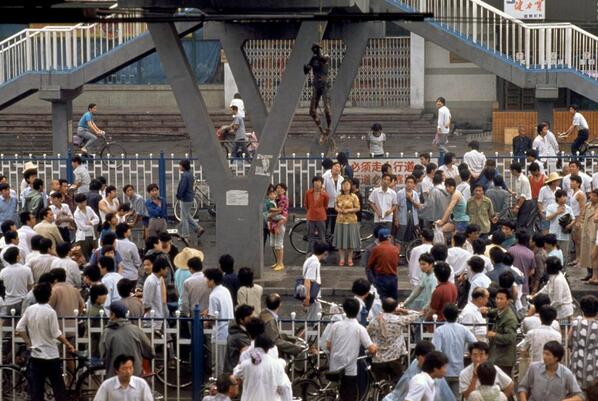
On farm visits I wandered through the useless pig iron remnants of valuable farm and house utensils thrown into crude three meter high mini-furnaces ordered by Mao and his regime.
China was going to beat the UK in steel production, it was claimed.
…
Later I was to visit Shanghai slums. There the frustration of the proletariat had turned to anger directed at anything in sight, including me. Some thug-like types were out for violence. I escaped, but barely.
In the universities, libraries had been purged of almost all but useless communist tracts. To provide sensible books would be a sign of bourgeois weakness and an excuse for beidoufa.
Sanity returned in the seventies and eighties but it was slow and hesitant.
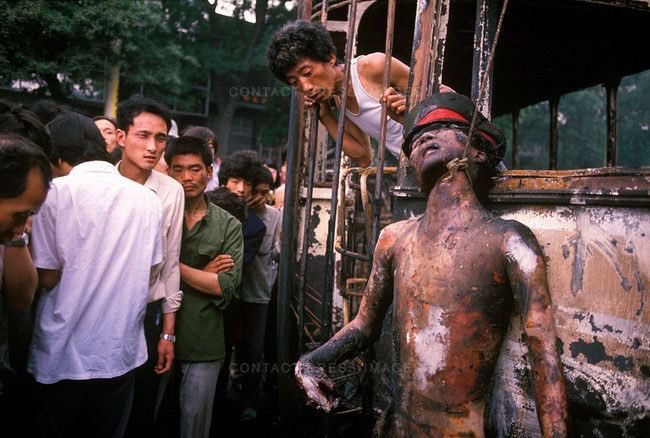
3. Tiananmen Square Massacre?
This was the setting for the Tiananmen Square protests. The record of the US Embassy and other reliable sources makes it clear the regime at first wanted to handle the students with kid gloves; after all, many of the students were the sons and daughters of the communist elite.
Unarmed soldiers were sent in, though subways and by buses, to persuade the students to leave.
They were met by crowds, including angry grand-mothers, at the subway exits and elsewhere and told to go home.
The bus contingent was less fortunate. It is clear from the photos that the leading buses were set alight leaving dozens of buses following vulnerable to the arsonists. Unarmed and having to struggle for the exits from burning vehicles, many ended up as our photos have shown – scorched, dazed and barely alive.
It was the day after – JUNE 4 – that armed troops were sent in. It seems unlikely they were sent in primarily to suppress student protestors in Tiananmen Square; as they stormed up Changan Avenue leading to towards the Square it seems clear they were out mainly get revenge for the atrocities unleashed by the crowds the previous day against their fellow soldiers and for the burning of he buses bringing them into town and from which they barely escaped – hundreds of burned-out busses jammed on entrance routes .
That revenge was wreaked on all and everyone who got in their way – citizens, student protestors, anyone. That was a semi-massacre, and it followed a worse semi-massace, but neither were in Tiananmen Square.
…
Most Western observers in the Square, a Spanish TVE television crew in particular near the monument in the Square center, reported they saw no violence and that the students left peacefully in the early hours of the morning of the next day.
Indeed, the then Spanish ambassador to China, Eugenio Bregolat (whom I later got to know in Tokyo) was so incensed by the massacre reports, that he later wrote a book about his experience and that of the TVE television crew.
He claimed that the reports of a massacre came manly from media people hiding in the Beijing Hotel nearby and unable to see the Square center. Having seen how media people behaved during the Jakarta riots that met Tanaka Kakuei’s visit some 25 years earlier I was not surprised at the inventivenes of their stories.
That said, it is possible some student protestors were killed in the more remote areas of the enormous Square; no one argues that not one of the troops sent in failed to reach the Square. But that must have been in the less visible parts of the Square. Too many Western observers, including some known to me personally, failed to see any violence in the main parts of the Square itself.
In short, the Tiananmen Square massacre was a myth. And one of the more mendacious variety
…
What does need to be explained is the lack of interest in the faces of the crowds witnessing attacks by thugs against the soldiers. And the reason is not hard to find – the Cultural Revolution was an unmitigated disaster impacting the lives of each and every citizen. The regime had lost all credibility. For the masses, it and its agents were something to be ignored. Let them burn.
…
Nor was the fact that among the 1989 masses there were some thugs out for blood and destruction.. Years of ridiculous, if not cruel, Cultural Revolution polices and the poverty it engendered would have produced a thuggish underclass only too ready to get revenge.
Those ghastly photos of mutilated soldiers are the proof.
In short, chaos reigned.
…
That said the regime also has its excuses. It did try to reach out to student leaders, only to be rebuffed by the more ambitious, cunning or violent among them.
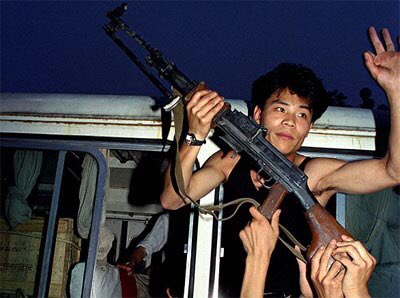
And it is an undeniable fact that dozens of troop carrying buses were torched as they tried to enter assembly points near the Square. The photos are there for all to see. How come we rarely hear about the photos? When, how and by who were the buses burned? They are far more crucial to the story that soldiers charging up Changan Avenue.
Even in the addled minds of our mendacious media that has to be something called cause and effect.
… .
And clearly there was some outside involvement. Chinese protesters did not have a record of using Molotov cocktails. Who educated or helped them?
Ever-active Western intelligence agencies had weeks to infiltrate the Square and the roads leading to it.
4. State Department Records
Amazingly, it is to the US State Department records we have to go to get an honest account of what actually happened.
They note that “.. the initial moves against the students suggested to many that the Chinese leadership was still, as of the morning of June 3, committed to a relatively peaceful resolution to the crisis.”
From there we go to:
“fascinating eyewitness accounts of the disorganized and confused retreat of PLA soldiers from the center of Beijing after their advance on Tiananmen Square was halted by crowds of demonstrators on the morning of June 3.’ (italics added)..’the soldiers were ridiculed by Chinese citizens and scolded by elderly women who called them “bad boys” and “a disgrace to the PLA”.
Would armed soldiers out to kill protestors let themselves be dictated to by elderly women?
On the day after, on June 4, however: “thousands of civilians stood their ground or swarmed around military vehicles. APCs were set on fire, and demonstrators besieged troops with rocks, bottles, and Molotov cocktails.”
Clearly something happened between the morning of June 3 and June 4 to stir up the masses – both the the protesting citizens and the thugs – and I suggest it was the arrival of revenge-seeking armed troops following the events of June 3.
That, folks, is the Tiananmen Square Massacre Story- in short, no Tiananmen Square, no Massacre and no corrrect Story.
Further details prove the embellisment of the story.
5.Tankman photo
Photos do not lie and perhaps the most famous photo to emerge from Tiananmen events has been labelled Tankman.
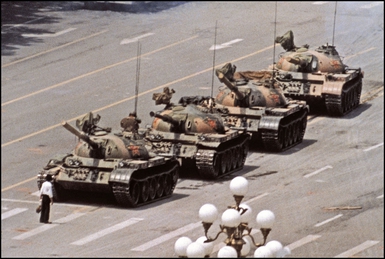
But this is not a photo of a brave student protestor confronting the might of the Chinese army.
It is a photo of a shopper playing with a tank with his shopping bag. The AP photographer, Jef Widener, also records that the tank was going away from, and not towards, the Square
And it the day after, not before, the June 3-4 events.
He also records that on the day before the photo he was almost killed as the crowds attacked a troop carrier.
All the News thats Fit to Print: the NYT.
The most egregious distortion to emerge from this potage of Tiananmen lies and violence came from the newspaper that likes to pretend to be the paper of record – the New York Times.
Taken from a Hong Kong newspaper with former credibility, Wen Wei Pao, and headlined ‘TURMOIL IN CHINA; Student Tells the Tiananmen Story: And Then, ‘Machine Guns Erupted’ it ran in full an obviously faked student account of events
‘The machine gunners took a prone position, with their backs to the Gate of Heavenly Peace. As soon as the placements were established, a huge number of soldiers and police appeared.’
Strangely no one in the Square at the time saw any of this.
Even the Times reporter, Nicholas Kristof, in the Square at the time had to try to play down the story. But his story was relegated to page eight and was largely ignored.
(Wen Wei Pao had been a strongly pro-regime paper. But its staff were so badly mauled by Cultural Regime fanatics (newspapers were their favourite targets) that in the Tiananmen excitement the editor was prepared to run any anti-regime story at hand. That was his revenge.
(And very effective. The story ran in a lull after the initial violence when the world was weighing up final judgement on what had happened.)
…
The BBC, that other voice of record, was also guilty.
Tiananmen Square protest death toll ‘was 10,000’
But instead of showing a picture of the claimed Tiananmen massacre, the BBC used a picture of a burning Tank.

The Australian official ABC managed to ignore how its Embassy reported a soldier being killed and disembowelled by its front gate.
…….
Please see some first hand reports and commentaries by others.
They are attached to let the reader draw his or her own conclusions of what happened.
See also
Tiananmen Square “Massacre”? The Power of Words vs. Silent Evidence (The Art of Media Disinformation is Hurting the World and Humanity) (Volume 2) [1 ed.]
Columbia Journalism Review